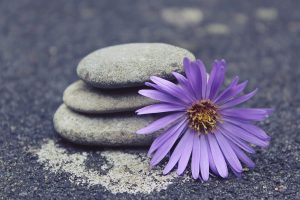 One of the toughest things about yoga is talking about it. Sanskrit words abound, and all of them look and sound so foreign to most of us. This is a quick guide to yoga and meditation terms. We have intentionally kept the definitions brief and jargon-free. Our sources included the good old Webster’s New Universal Unabridged Dictionary as well as excellent yoga references such as Autobiography of a Yogi.
One of the toughest things about yoga is talking about it. Sanskrit words abound, and all of them look and sound so foreign to most of us. This is a quick guide to yoga and meditation terms. We have intentionally kept the definitions brief and jargon-free. Our sources included the good old Webster’s New Universal Unabridged Dictionary as well as excellent yoga references such as Autobiography of a Yogi.
Ahimsa. Noninjury, nonviolence, harmlessness (one of the yamas).
Ananda yoga. Gentle, inward yoga that uses silent affirmations while in the asanas (postures).
Anusara yoga. Called heart-oriented, this yoga integrates the celebration of the heart, universal principles of alignment, and energetic asanas.
Aparigraha. Nongreed (one of the yamas).
Asanas. Yoga postures. Probably the most famous pose is the lotus position, which can really tangle up beginners. Don’t do this one without professional help. Pronounced AH-sah-nahs. See article on Patanjali’s Eightfold Path.
Ashram. Retreat or secluded place, usually where the principles of yoga and meditation are taught and practiced.
Ashtanga yoga. Physically challenging yoga to build strength, flexibility, and stamina. Also called power yoga.
Asmita. Ego, individuality, I-am-ness.
Asteya. Nonstealing (one of the yamas).
Bhakti yoga. The path of devotion (see article on Yoga Paths).
Bikram yoga. A rigorous yoga performed in a hot environment.
Brahmacharya. Purity, chastity, nonlust (one of the yamas).
Brahman. The absolute. Divinity itself, God as creator. When Ralph Waldo Emerson’s poem “Brahma” appeared in the Atlantic Monthly in 1857, most of the readers were bewildered. Emerson chuckled. “Tell them,” he said, “to say ‘Jehovah’ instead of ‘Brahma’ and they will not feel any perplexity.” (from Autobiography of a Yogi)
Buddhi. The intellect.
Chakras. Centers of radiating life force or energy that are located between the base of the spinal column and the crown of the head. Sanskrit for “wheels.” There are seven chakras that store and release life force (prana).
Dharana. From the word dhri meaning “to hold firm,” this is concentration or holding the mind to one thought. See article on Patanjali’s Eightfold Path.
Dharma. Self-discipline, the life of responsibility and right action.
Dhyana. Meditation or contemplation. The process of quieting the mind. See article on Patanjali’s Eightfold Path.
Guru. Spiritual teacher, described as the “dispeller of darkness.”
Hatha yoga. Many yoga styles spring from hatha. It is the yoga of physical well-being, designed to balance body, mind, and spirit.
Integral yoga. This yoga style places almost as much emphasis on pranayama (control of breath) and meditation as it does on postures.
Ishvar-pranidhana. Center on the Divine (one of the niyamas).
Iyengar yoga. This yoga style focuses on the body and how it works. It is noted for attention to detail, precise alignment of postures, and the use of props.
Jnana yoga. The path of knowledge or wisdom (see article on Yoga Paths).
Karma yoga. The path of action (see article on Yoga Paths).
Kripalu yoga. This yoga style emphasizes proper breath, alignment, coordinating breath and movement, and “honoring the wisdom of the body.”
Kundalini. A cosmic energy in the body that is often compared to a snake lying coiled at the base of the spine, waiting to be awakened. Kundalini is derived from kundala, which means a “ring” or “coil.”
Kundalini yoga. Chanting and breathing are emphasized over postures in this ancient practice designed to awaken and control the release of kundalini energy.
Mandala. A circular geometric design that represents the cosmos and the spirit’s journey. It is a tool in the pilgrimage to enlightenment. One of the most famous mandalas appears on the floor of the Chartres Cathedral in France. It is not uncommon for churches in the United States to recreate well-known mandalas and call them labyrinths. Spiritual pilgrims literally walk the labyrinth to attain spiritual insight.
Mantra. Sacred chant words.
Meditation. Technique of inward attention. Psychologist Lawrence LeShan offers a down-to-earth definition: The goal of meditation is “to enable you to get more out of life and to move more completely in whatever directions you choose.” Those directions can range from moving toward inner peace and higher spirituality to losing five pounds before Christmas.
Mudras. Hand gestures that direct the life current through the body.
Namaste. This Hindu salutation says “the divine in me honors the divine in you.” The expression is used on meeting or parting and usually is accompanied by the gesture of holding the palms together in front of the bosom. Pronounced NUM-ah-stay.
Neti-neti. Means “Not this. Not this.” In meditation, you gently dismiss thoughts, images, concepts, sounds, and distractions by applying the principle of neti-neti or telling yourself, “Not this. Not this.”
Niyamas. In the Yoga Sutras, Patanjali defined five niyamas or observances relating to inner discipline and responsibility. They are purity, contentment, self-discipline, study of the sacred text, and living with the awareness of God. See article on Patanjali’s Eightfold Path.
Om or Aum. Mantric word chanted in meditation. Paramahansa Yogananda called it the “vibration of the Cosmic Motor.” This one word is interpreted as having three sounds representing creation, preservation, and destruction.
Prana. Life energy, life force, or life current. We also like Yogananda’s description of prana as lifetrons. These finer-than-atomic energies have inherent intelligence, according to Yogananda, as opposed to atoms and electrons, which are considered to be blind forces. The Chinese call this life force chi.
Pranayama. Method of controlling prana or life force through the regulation of breathing. See article on Patanjali’s Eightfold Path.
Pratyahara. Withdrawing the senses in order to still the mind as in meditation. See article on Patanjali’s Eightfold Path.
Raja yoga. The path of physical and mental control (see article on Yoga Paths).
Santosha. Contentment (one of the niyamas).
Satya. Truthfulness and honesty (one of the yamas).
Samadhi. State of absolute bliss, superconsciousness. Yogananda called this the “state of God-union.” See article on Patanjali’s Eightfold Path.
Shauca. Purity, inner and outer cleanliness (one of the niyamas).
Shodhana. Yogic cleansing ritual.
Sivananda yoga. Relaxed and gentle yoga that encourages a healthy lifestyle: proper exercise, proper breathing, proper relaxation, proper diet, and positive thinking with meditation.
Svadhyaya. Self-study. The process of inquiring into your own nature, the nature of your beliefs, and the nature of the world’s spiritual journey (one of the niyamas).
Swami. Title of respect for a spiritual master.
Tantra yoga. This yoga uses visualization, chanting, asana, and strong breathing practices to tap highly charged kundalini energy in the body.
Tapas. Self-discipline or austerity (one of the niyamas).
Ujjayi. Breathing exercise that produces sound in the throat with the inhalation. Pronounced you-jie-ah.
Viniyoga. A gentle form of flow yoga in which poses and flows are chosen to suit the student’s abilities.
Vinyasa. Steady flow of connected yoga postures linked with breath work in a continuous movement. For example: sun salutation.
Yamas. In the Yoga Sutras, Patanjali defined five yamas or ways to relate to others — moral conduct. They are nonviolence; truth and honesty; nonstealing; moderation; and nonpossessiveness. See article on Patanjali’s Eightfold Path.
Yoga. Derived from the Sanskrit word for “yoke” or “join together.” Essentially, it means union. It is the science of uniting the individual soul with the cosmic spirit through physical disciplines (postures) and mental disciplines (meditation). Patanjali offers the best definition: “Yoga is the cessation of mind.”
Yogi. Someone who practices yoga. (A female yoga is called a yogini.)
_________________________
I write mysteries about a yoga teacher, Maya Skye, and all the titles have a yoga pose in them. They are packed with fun. Check out my Maya Skye mysteries and read about this crime-fighting yoga teacher in: Down Dog Diary (book 1), Warrior’s Revenge (book 2), and Crow Calling (book 3).





